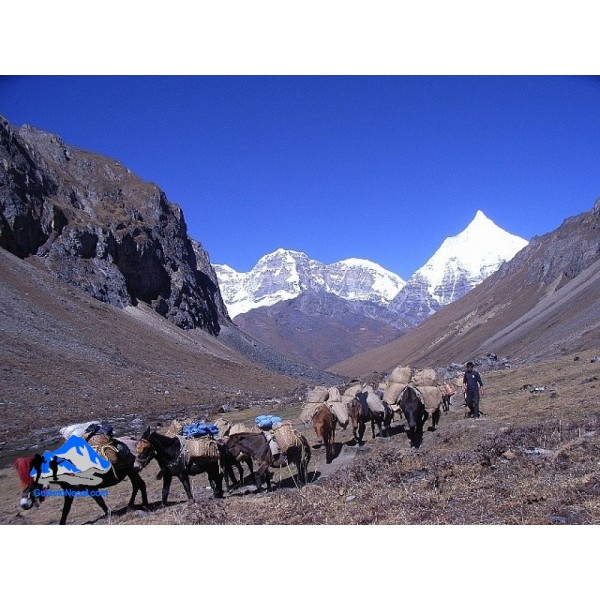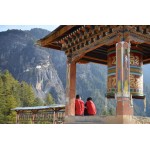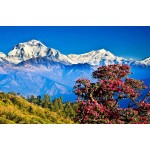Itinerary -
DAY 01: Bagdogra - Phuentsholing (Drive 175 km / Drive Approx 3.5 - 4 hrs)
Namoh guide will meet you at a pre designated point in Siliguri near the Bagdogra airport & NJP railway station. We will start on the drive to Phuentsholing by 2 p.m. The drive today is through the mightyplains of Bengal amidst many tea gardens, small towns and villages until you reach Phuentsholing which is the Indo-Bhutan border, a bustling commercial town. Free to explore the town on your own. Overnight in a hotel
DAY 02: Phuentsholing - Paro (Drive 180 km / 5 - 6 hrs)(Trek / 2 - 3 hrs)
After breakfast and completing some permit formalities, you now ascend into the hills of the magical land of Bhutan. The drive takes you to heights of 2800m in about 4 hrs from sea level, with altitude changes the flora and fauna of the region. You come across the towns of Gedu, Chukha and many small settlements along the route. We will have lunch enroute and reach our destination, Paro around early evening. Paro is a beautiful town set in a majestic valley with the meandering Paro river flowing through it. We check into the hotel and without wasting anytime get down to business. We set out on a walking tour of Paro. Overnight in a hotel
DAY 03: Paro Sightseeing & Hike to Taktsang (Trek / 3 - 4 hrs)
Today is a special day as you hike up to one of the most famous sight & monastery in Bhutan, Taktsang (Tiger Nest) monastery. After an early breakfast we take a short drive to the starting point and from there take a hike to the Taktsang Monastery. Guru Padmasambhava or Guru Rimpoche did his meditation here for 3 months. The hike takes about 3 – 4 hrs depending on the capability of the hikers. This is also a photographer’s delight; the monastery is adorned with prayer flags and the stands in the cave of granite rocks 300m above the valley floor. Tea/Coffee will be served in the viewpoint cafeteria. We finish the trek and on the way back to the hotel visit the Kichu monastery which is one of the oldest monasteries in Bhutan built in the 7th century by the Tibetan King Songsten Genpo who built 108 monasteries around the region with the last being Lhasa in Tibet. We will also visit Drugyal Dzong at the end of the valley to complete our exploration of Paro valley. Overnight in a hotel.
DAY 04: Paro - Jili Dzong (3450m) (Trek / 4 - 5 hrs)
We start our trek from the Paro National Museum along a route that is part of the original mule track that linked Thimphu Valley with Paro Valley and ultimately connected Bhutan to the Indian border. The trek for the day is fairly short but is mostly uphill. During the day you get wonderful views of the Paro valley. In the initial stages you walk through pine and bamboo forest, followed by birch and finally rhododendron. There is a chance of spotting many birds and you will definitely get to see a lot of Himalayan flora. We reach our campsite, just below the Jili Dzong, and setup camp here for the night. Overnight in tents.
DAY 05: Jili Dzong - Jangchulakha (3760m) (Trek / 5 - 6 hrs)
In the morning, we make a visit to the Dzong before we set off on the day’s walk. We spend some time exploring the fortress as we have a short trekking day today. Once we set off on the trek, we have a number of ascents and descents through the day and if the weather is clear we get beautiful views of Bhutan’s second highest peak, Chomolhari (7314m) and many smaller peaks. We are likely encounter yak herders camped in their usual black woven yak hair tents. We reach Jangchulakha, which is a large yak pasture, and we set up camp here for the night. Overnight in tents.
DAY 06: Jangchulakha -Jimilang Tsho - Jana Tsho (3956m) (Trek / 7 - 8 hrs)
We start the day with an ascent and then follow the ridge to a high point. You get brilliant views of the big peaks of the Himalayas and then you cross a small pass to finally emerge above the Jimilang Tsho (lake). Jimilang Tso means ‘Sand Ox Lake’ and is named after a bull that emerged from the lake to graze in the local pastures. The lake is full of trout, and fishing here is allowed with permit. From here we climb up through cliff paths with sheer drops and after a series of ridges, we arrive at the second lake and our campsite for the night, Jana Tsho. Overnight in tents.
DAY 07: Jana Tsho - Phajoding (Trek / 6 - 7 hrs)
We begin the walk from here through rhododendrons and then we come to the 3rd lake in this area, Simkotra Tsho. We also cross the highest point/Pass on this trek, Simkotra La or Phume La at 4210m. The path is a mixture now of small passes and mountain trails. You may meet monks on their way from Thimphu to visit the sacred lake of Jimilang Tsho, where they meditate for a few days before returning. Lower down there is a smaller pass with a chorten which looks directly down onto the sprawling Thimphu valley. Depending on clear weather, you would get great views of the big peaks including Gangkhar Puensum (7541m), the highest peak in Bhutan and the highest unscaled peak in the world. From here the path zigzags down to Phajoding. Overnight in tents
DAY 08: Phajoding - Thimphu (2300m) (Trek / 3 - 4 hrs)
The trek to Thimphu is downhill all the way through a forested area of mostly blue pine. The walk, at a leisurely pace, takes about three hours. Once you reach your hotel you can treat yourself to a nice leisurely a hot shower and a delicious meal. You can spend the rest of the evening exploring this beautiful capital city of Thimpu. Overnight in a hotel
DAY 09: Phajoding - Thimphu (2300m) (Trek / 3 - 4 hrs)
Today visit Simtokha Dzong, Kingdom’s oldest Dzong built by Shabdrung Ngawang Namgyal. Visit the handicrafts emporium where Bhutanese textiles and other arts are displayed and can be purchased memorial Chorten, built in the memory of Third King of Bhutan. After lunch relax for sometime and later explore the small but extremely charming Thimphu city and the curio shops around the city. We also visit Tashichho Dzong, Thimphu’s most impressive building situated at the banks of Wang Chhu. It houses the King’s Throne room and it is also the summer residence of the Chief Abbot. Overnight in a hotel
DAY 10: Thimphu - Punakha (1250m) - Thimphu(Drive 80 kms) (one way)
After breakfast you have the option today to drive to Punakha valley and visit the beautiful Punakha Dzong and Chimey Lhakhang/Monastery. The dzong here is surely the most beautiful one in Bhutan. Punakha used to be the capital of Bhutan between 17 – 19th century. This trip takes about 2 to 2.5 hrs one way and goes through the famous Dochula pass from where one gets very good views. The dzong here is a sight to behold and a presents a memorable cultural insight into the unique culture of Bhutan. People not interested in going to Punakha can explore the beautiful outskirts of Thimpu today. There are several wonderful trails all around. Overnight in a hotel
DAY 11: Drive Back To Bagdogra / NJP / Siliguri From Thimphu (Drive / 8 - 9 hrs)
Today we start from Thimpu at around 5 a.m and reach Siliguri by 1 or 2 p.m. we have breakfast enroute.
Trip Ends With Sweet Memories !!!
List of Essentials
Mountain/adventure travel requires one to be adequately equipped with the right kind of personal gear. Since one is travelling in the wilderness there will be hardly any opportunity to buy anything once you hit the trail so we urge you to carefully pack everything into your bags. Also please keep in mind you can rent out or purchase equipment from our Gear Store, if required.
Jeans / Trekking Pants - 2
Windproof jacket of decent quality (no flimsy wind cheaters please!) preferably with a hood
Warm and thick Fleece / Full-sleeve Woollen sweater
Thermal inner wear (upper & lower)
Woollen cap
Woollen gloves
Woollen socks & regular socks (3-4 pairs)
Scarf/muffler (optional)
Comfortable Trekking/Hiking shoes (shoes with a thick sole are recommended)
Lightweight floaters/sandals/slippers
Raincoat / Poncho
Small light weight towel
Water bottle (sturdy ones, no empty Bisleri bottles!!)
Cap / Hat to keep the strong sun away from your face
Sun glasses
Walking stick / Trekking pole
Sunscreen Lotion
Lip Balm
Torch / Flashlight (with extra batteries)
Medicines, if requiring any specific medication
Personal toiletries
Books, if you like reading
Day pack/small bag which you will carry on your back every day and keep your essentials in it
Carry rain cover for your bags
Keep a few poly bags or waterproof bags in your bag in which if required you can put your belongings in case of heavy rain
Camera if you like (with fully charged batteries)
…LOADS OF ENTHUSIASM!! AND A PLEDGE TO LEAVE NO TRACE
Carry your stuff in a duffel bag, soft shoulder bag or a rucksack. Avoid suitcases, trolleys or any other hard luggage. As you will be walking long distances carrying a rucksack, avoid bringing unnecessary items on the trek. Please avoid carrying expensive watches, jewellery and electronic items on the trek
For Departure Dates just call 7350530009 / 7350540009 / 7350550009
Transport Options (Arrival Departure from Bagdogra)
For travel to Bagdogra & back one can choose between air and rail. For air travel, Bagdogra is well connected to Delhi and other parts of the country by Indigo, Air India, Jet Airways and other commercial airlines. Train travel is also recommended with a number of options available with the closest railway station being New Jalpaiguri.
Weather Details
The climate in Bhutan varies widely depending on the elevation. In the southern border areas it is tropical; at the other extreme, in the high Himalayan regions, there is perpetual snow. Temperatures in the far south range from 15°C in winter (December to February) to 30°C in summer (June to August). In Paro the range is from -5°C in January to 30°C in July, with 800mm of rain. In the high mountain regions the average temperature is 0°C in winter and may reach 10°C in summer, with an average of 350mm of rain. Rain occurs primarily during the southwest monsoon season from June to September.
Please keep in mind that the above information is not exact and does not account for sudden changes. Whatever the temperatures and conditions rest assured we will be prepared to handle it with ease as we use equipment of very high specifications.
Duration: 11 Days
Season: Feb - May, Sep - Dec
Grade: Moderate +
Region: Bhutan
Description
Bhutan is undoubtedly the most exotic region in the entire Himalayas. What sets it aside from the other Himalayan regions, other than its stunning landscapes, is the presence of an extremely rich culture & the beautiful & ever welcoming people that inhabit this land. The experience Bhutan presents is magical, very different from anything else and one which lingers on for a long period. Everything here has a past and an interesting story around it. So for people who love mountains and the stories that have existed within these mountains for centuries, this is a perfect destination
One visit to Bhutan and the word Lush Green would have a completely different meaning for you. Just six hundred thousand people within its boundaries and a culture which loves conservation has ensured that the forests and foliage is absolutely untouched and pristine. The land is blessed with several high valleys characterized by vast flat undulating meadows which play host to quaint villages. The wide valleys here are something very rare in other regions of the Himalayas
The Druk Path is Bhutans classic and most popular trek and rightly so. This six day trek is of moderate difficulty and follows the ancient highland route between Paro and the capital of Bhutan, Thimpu. The trek passes through a gorgeous natural landscape of blue pine forests, high ridges and pristine lakes and all this with a rich and intoxicating flavour of cultural experiences. While on the trek there are several opportunities to visit some ancient lhakhangs (monasteries), dzongs (fortress) and villages. Views of the snow capped Himalayan giants along the trail is an added bonus on the trek
The trekking section of the trip starts with an acclimatisation hike to the Taktsang monastery (Tigers Nest) for a splendid view of the Paro valley. Once on the main trekking trail you walk through forests of fir, blue pine and dwarf rhododendrons at altitudes ranging between 2400-4200 m. It starts with a trek to the ruined Jili Dzong, which is on an elevated ridge above the Paro Valley. It commands breath-taking views of the Chomolhari (7314m), also known as the Bride of Kangchenjunga. During the succeeding days of trekking, you will climb above the tree line and cross several passes, including the Phume La (4210m). Enroute, you will camp beside clear mountain lakes (on the third day hikers will pass Jimilang Tsho, whose crystal clear waters are home to gigantic trout), visit encampments of yak herders and enjoy magnificent vistas of the peaks on the border with Tibet, including Chomolhari and Gangkhar Puensum, the highest unscaled peak in the world, at an elevation of 7541m
Bhutan is easily accessible from India. You can fly directly from New Delhi, Mumbai, Calcutta & Bagdogra and join the group at Paro OR you could fly in or take a train to reach Siliguri (Bagdogra airport & NJP railway station are very close by) and from here drive to Paro as mentioned in the itinerary.









